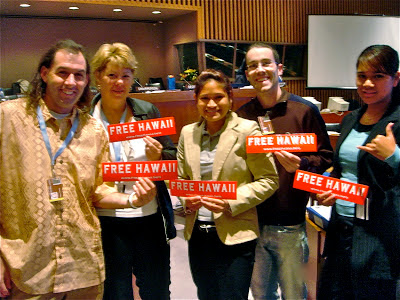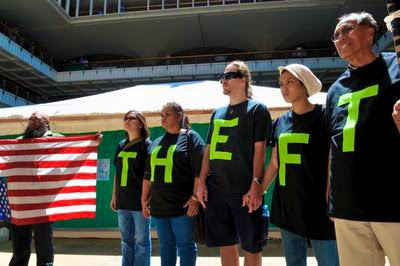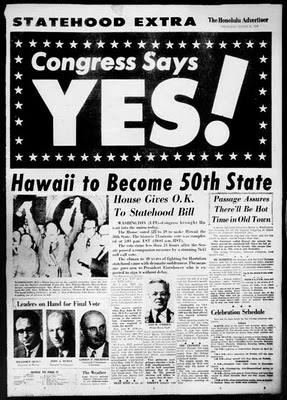All Posts (6434)
It seems this case has been down-played and reminiscent of the Massie case. For transparency sake and that of justice, we need an update of this.
"Lehua Poi - A Visit With Nakulu Arquette"
For centuries poi has been the staple diet of Hawaiians. But because itʻs so labor intensive to make by hand, poi makers today have experienced great difficulty staying afloat. And thatʻs why we went to Kaua`i to meet Nakulu Arquette, the new owner of Lehua Poi. See for yourself as Nakulu not only gives us a tour of his factory, but tells us how his recipe for success is different from all the rest - Watch It Here
MONDAY, May 27th At 5:30 PM – O`ahu - `Olelo, Channel 53
MONDAY, May 27th At 6:30 PM – Maui – Akaku, Channel 53
MONDAY, May 27th At 7:00 PM & FRIDAY, May 31st At 5:30 PM – Hawai`i Island – Na Leo, Channel 53
TUESDAY, May 28th At 7:30 PM, THURSDAY, May 30th At 7:30 PM & SATURDAY, June 1st At 8:00 PM - Kaua`i - Ho`ike, Channel 52
Sneak Peek!
"A Gun To The Head - A Visit With Kyle Kajihiro"
Not many people know that Hawai`i is one of the most militarized pieces of real estate on earth. Even fewer are aware that Pearl Harbor, known anciently as Keawalau O Pu`uloa, was once one of the largest food producing complexes in the entire Pacific. And thatʻs only part of what we learned from our tour with long-time peace and justice activist Kyle Kajihiro. Donʻt miss one of our most amazing interviews yet as Kyle shows us what this “Pearl Of The Pacific” once was and could be again - Watch It Here
SATURDAY, June 1st At 8:00 PM – O`ahu - `Olelo, Channel 53
Now you can become a fan of Voices Of Truth on Facebook by clicking Here and see behind the scenes photos of our shows and a whole lot more.
Voices Of Truth interviews those creating a better future for Hawai`i to discover what made them go from armchair observers to active participants. We hope you'll be inspired to do the same.
Voices Of Truth now airs on local access stations in over 70 cities across the US and throughout the world. Check your local listings.
If you support our issues on the Free Hawai`i Broadcasting Network, please email this to a friend to help us continue. A donation today helps further our work. Every single penny counts.
Donating is easy on our Voices Of Truth website via PayPal where you can watch Voices Of Truth anytime.
For news and issues that affect you, watch Free Hawai`i TV, a part of the Free Hawai`i Broadcasting Network.
Please share our Free Hawai`i Broadcasting Network videos with friends and colleagues. That's how we grow. Mahalo.
Hawai`i is not, and has never been in or a part of the United States.
So you cannot secede from something you've never been legally part of.
You cannot quit something you didn’t join. You cannot resign from something to which you don’t belong. You cannot divorce from someone to whom you were never married.
Hawai`i regaining its independent status is a matter of reinstatement; of putting something back into its rightful place.
Since Hawai`i was never lawfully made a part of the United States, its rightful place is still that of a sovereign, independent nation.
The current status of Hawai`i is that it’s people, lands and government are being held captive by the US.
The Free Hawai`i movement is not seeking to secede from a bad union, it is seeking freedom from captivity, and the freedom to resume Hawaii’s status as a sovereign and independent nation.
All land in Hawai`i was initially stolen in 1893 by a small group of foreign men who subsequently formed the Provisional Government.
Failing at its first attempt in 1894 to be annexed by the US Government, the provisional government reincorporated themselves into the Republic of Hawai`i.
The Republic of Hawai`i totaled less than 4,000 citizens, mostly white foreigners, compared to the 45,000 or more non-whites living throughout Hawai`i at that time.
It was the Republic of Hawai`i that later exchanged stolen property (lands now known in part as the so-called “ceded lands”) with the US.
FREE HAWAI`I TV
THE FREE HAWAI`I BROADCASTING NETWORK
"INSISTING FOR RELISTING"
All Doubt Is Gone, Because Theyʻre Now Back On.
For Years Theyʻve Persisted & Last Week Got Relisted.
For Themselves They Can Now Decide Whatʻs Long Been Denied.
So Watch This As We Reveal Why This Is Such A Big Deal.
Then Share This Video With One Other Person Today.
WANT THE FACTS?
Go Here - HawaiiFakeState.com
ERE IS A BETTER FLYER WHICH YOU CAN CLICK TO GET TO THE PETITION.
PLEASE HELP US WITH THIS PETITION, WHICH IS OUR LAST CHANCE TO PROTECT THE BURIALS OF OUR ELDERS AND OUR HISTORIC SITES. SB 1171 IS THE START OF THE DISMANTLING OF EXISTING LAWS THAT PROTECT HAWAIIANS AND THEIR CULTURE.
CLICK ON THE PETITION TO SIGN AND SHARE WITH YOUR CONTACTS.
MAHALO, WALTER RITTE
From: kehaua@oha.org
To: rittew@hotmail.com
Subject: FW: Clickable Image - Itʻs important to keep HTML formatting in the email you send for this to work
Date: Tue, 21 May 2013 01:24:57 +0000
Click here to sign the Malama Coalition petition on change.org that urges Governor Neil Abercrombie to veto SB1171 on the basis that the bill ignores sound planning and disrespects iwi kupuna, the Native Hawaiian host culture, and the historic landmarks of Hawaii.
See Behind The Scenes Shots Of Our Shows
Click HERE To Become A Fan
"Lehua Poi - A Visit With Nakulu Arquette"
For centuries poi has been the staple diet of Hawaiians. But because itʻs so labor intensive to make by hand, poi makers today have experienced great difficulty staying afloat. And thatʻs why we went to Kaua`i to meet Nakulu Arquette, the new owner of Lehua Poi. See for yourself as Nakulu not only gives us a tour of his factory, but tells us how his recipe for success is different from all the rest - Watch It Here
MONDAY, May 20th At 5:30 PM – O`ahu - `Olelo, Channel 53
MONDAY, May 20th At 6:30 PM – Maui – Akaku, Channel 53
MONDAY, May 20th At 7:00 PM & FRIDAY, May 24th At 5:30 PM – Hawai`i Island – Na Leo, Channel 53
TUESDAY, May 21st At 7:30 PM, THURSDAY, May 23rd At 7:30 PM & SATURDAY, May 25th At 8:00 PM - Kaua`i - Ho`ike, Channel 52
Now you can become a fan of Voices Of Truth on Facebook by clicking Here and see behind the scenes photos of our shows and a whole lot more.
Voices Of Truth interviews those creating a better future for Hawai`i to discover what made them go from armchair observers to active participants. We hope you'll be inspired to do the same.
Voices Of Truth now airs on local access stations in over 70 cities across the US and throughout the world. Check your local listings.
If you support our issues on the Free Hawai`i Broadcasting Network, please email this to a friend to help us continue. A donation today helps further our work. Every single penny counts.
Donating is easy on our Voices Of Truth website via PayPal where you can watch Voices Of Truth anytime.
For news and issues that affect you, watch Free Hawai`i TV, a part of the Free Hawai`i Broadcasting Network.
Please share our Free Hawai`i Broadcasting Network videos with friends and colleagues. That's how we grow. Mahalo.
Ugh! Mr. Morgan the owner of Kualoa Rnch is draging my Ohana through Court for Quiet Title Action (KUALOA RANCH, INC., VS NAHOLOWAA - CIVIL# 13-1-0038-01 ECN). These lands has been in my Ohana for over 300 years, my father Melvin Rodrigues is and has been living on the land in Hakipuu on the windwardside of Oahu for a few years now. Sorry KUALOA RANCH but I can't and will not let that happen. May Ke akua watch over and bless us. Mahalo nui loa
Radio New Zealand International - May 17, 2013
The United Nations General Assembly has put French Polynesia (Tahiti) back on the UN list of territories to be decolonized at a meeting boycotted by France.
The resolution, passed by consensus, was sponsored by Solomon Islands, Nauru and Tuvalu last February but not tabled until today.
It calls on France to intensify its dialogue with French Polynesia to include a fair self-determination process.
France withdrew its Pacific territories from the UN list in 1947 and resisted the re-inscription bid by the French Polynesian government, whose term is set to end in a few hours after its election loss two weeks ago.
The campaign was driven for decades by the pro-independence politician, Oscar Temaru, who flew to New York to attend today’s vote.
The newly-elected majority in the French Polynesian assembly held its first sitting yesterday and controversially changed the agenda to hold a vote wishing an immediate end to the decolonization process.
France has immediately condemned the UN move, describing it as a glaring interference in its affairs and a total lack of respect for the choice made by Polynesian voters.
Find Out Here - HawaiiFakeState.com
Aloha kakou.
Professor Puakea Nogelmeier has had an article on the benefits of Hawaiian language published in "MidWeek" of late:
http://www.midweek.com/hawaiian-language-benefits-all/
Aloha.
Of the 40,000 non Kingdom subjects in Hawai`i at the time of the illegal 1898 overthrow, only 1,928 or so were U.S. nationals as documented by the 1900 census.
They represented less than 3% of the entire population.
The rest of the non U.S. aliens were not supportive of the illegal annexation of Hawai`i by the US.
This means that less than 3% of the population, all U.S. aliens, hijacked the Hawaiian Nation against the wishes of almost everybody else.
FREE HAWAI`I TV
THE FREE HAWAI`I BROADCASTING NETWORK
"FOUR TO RESTORE"
Itʻs A Movement Thatʻll Not Relent, Because Of Growing Discontent.
More & More Perceive Itʻs Time For These To Leave.
Weʻre Talking Decolonization, Which Means A Nationʻs Restoration.
Then Share This Video With One Other Person Today.












